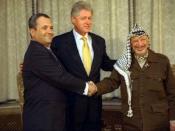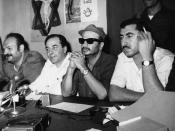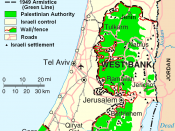Palestinian Liberation Organization,
Introduction
----This paper will provide an overview of the Palestinian Liberation Organization,
including its early history and its rise to prominence during the Intifada that began in 1987.
It will also include a description of Yasser Arafat's ascendancy to the leadership of the
PLO, a position that earned him the right to speak for all Palestinians by virtue of the
peace framework signed by him and the former Israeli Prime Minister Yitsak Rabin in
1993.
Early History
----Growing Palestinian activism in the early part of the 1960's provided the impetus for
the convening of the first summit conference of Arab leaders in 1964 -- to plan a unified
response to
Israeli plans to divert some of the waters of the
Jordan River. This activism influenced the
decision, made at that conference, to create the
PLO. It also precipitated the slide of the Arab
states into the June 1967 war with Israel.
In the
mid-1960's the Arab regimes were again haunted by
a force they had not had to deal with since 1948:
a Palestinian nationalist movement that, in spite
of being divided into several underground groups,
could exert great pressure on them by playing on
public opinion and inter-Arab pressures.
----During the early and middle 1960's
dissatisfaction with the Arab status quo fueled
the growth of Palestinian nationalist groups. Most
successful was Fatah, headed by Yasser Arafat
(discussed below) which began military operations
against Israel on Jan. 1, 1965, with an attack on
the Israeli national water carrier project to
transfer water from the Jordan River to the south
of Israel. Although little more than pinpricks to
the Israelis, these attacks were effective armed
propaganda in the Palestinians' political
offensive to force the Arab regimes, particularly
Egypt under Gamal Abd al-Nasser, to practice what
they preached regarding Palestine. The first
target chosen by Fatah was especially symbolic,
since none of the Arab summit meetings called to
deal with Israel's Jordan River water diversion
had resulted in any concrete action. This pattern
of armed propaganda continued to characterize
Palestinian armed attacks. It was aimed at winning
Palestinian opinion over to Fatah and at
convincing Arab public opinion of the feasibility
of direct action against Israel.
----The June 1967 war, in which several Arab
nations were soundly defeated by Israel, was
nonetheless a watershed that led to the rebirth of
a Palestinian national movement with a strong
separate identity. The rebirth occurred in
several stages. The first was winning a crucial
victory in the battle of Karameh in the Jordan
river valley in March 1968, where outnumbered
Palestinian guerrillas, backed by Jordanian
artillery, stood up to Israeli armored forces.
The importance of this battle was not in the
relatively limited Israeli losses, but in the
fact that the Israelis appeared to have been
driven back by Palestinian irregulars only nine
months after the rout of three Arab regular armies
in 1967. During the next stage, also in 1968, the
Palestinian guerrilla groups, who called
themselves fida'iyeen (fedayeen), or
self-sacrificers, seized control of the PLO from
the leadership that had been installed by Egyptian
President Gamal Abd al-Nasser in 1964.
Arafat's Rise
----Arafat was born in Jerusalem in 1929 and
brought up in Gaza. He studied civil engineering
at Cairo University, where he headed the League of
Palestine Students (1952-1956), and fought in the
Suez war of 1956. In the late 1950's he lived in
Kuwait and helped to establish Fatah, which began
terrorist operations against Israel in the early
1960's. From about 1965, and particularly after
Israel's victory in the 1967 Arab-Israeli war, a
power struggle developed within the Palestinian
resistance movement, mainly between advocates of
Arab state sponsorship and those, like Arafat,
supporting an independent movement. In 1969
Arafat, as leader of the most powerful group in
the PLO, was elected chairman.
----Under Arafat's leadership, the PLO developed
a variety of political, socioeconomic, and
educational institutions in Lebanon and elsewhere
in the Palestinian Diaspora. Arafat's greatest
efforts, however, were seen in the diplomatic
arena, where he doggedly pursued the goal of
international recognition of the rights of
Palestinians to self- determination and of the
PLO as their legitimate political representative.
Because of his desire to press for a diplomatic
solution he undertook initiatives that at times
were unacceptable to the Palestine National
Council (PNC), the Palestinian people's
"parliament in exile."
----In the late 1960's, Arafat supported the
PNC's call for a secular democratic state in all
of Palestine, to be achieved by guerrilla attacks
against Israeli targets. This strategy lost
credibility in the aftermath of the 1973
Arab-Israeli war, and in 1974 the PNC agreed to a
Palestinian state in any part of Palestine. From
then on, Arafat remained a backer of what was
understood to represent a "two-state" solution.
The Intifada: The Palestinian Mass Uprising
----The rise of the PLO to the world stage really
began with the well-known intifada, or mass
uprising, in the West Bank and Gaza Strip. It was
at the end of 1987 where resistance to Israel's
occupation of the West Bank and Gaza strip began
to sharply escalate in the form of demonstrations,
strikes, boycotts, and violence. It came to
involve virtually the whole Palestinian population
in those areas, and continued even two years later
in spite of the hundreds of Palestinian deaths and
thousands of detentions that came at the hands of
Israeli police forces.
----The uprising was the product of a generation
that had been brought up under Israeli control.
By the late 1980's two out of every three
Palestinians in the West Bank and Gaza Strip had
either been born or were less than five years old
when the Israeli occupation began. For two decades
the people had no control over their own lives
and their future was becoming increasingly unsure.
This was primarily due to the creeping annexation
of land by the Israeli occupation authorities and
the establishment of Israeli settlements on the
confiscated lands. By 1993, more than 60 percent
of the West Bank land and about 50 the land of the
overcrowded Gaza Strip had been appropriated by
Israel (Peretz, 1990). Some of it was destined
for Jewish settlements, inhabited in many cases by
militant right-wing settlers seeking Israeli
annexation of these areas. The settlements were
meant to "establish facts," and hence make
Israeli control irrevocable. The presence of these
settlers seriously worsened the tensions between
Palestinian and Jewish settlers.
----For two decades Israel had done much to
prevent independent economic or social development
and to subject the West Bank and Gaza Strip to the
needs of the Israeli economy: these areas became
the second largest market for Israeli exports,
provided a pool of cheap labor for Israel, and
offered a field for lucrative Israeli investment.
West Bank and Gaza Strip workers had to pay part
of their low salaries into the Israeli social
security fund, but could not receive benefits. All
residents were heavily taxed, but the Palestinian
workers received much less benefits than the
Israelis enjoyed. It came to the point that the
occupation not only paid for itself but became
profitable to the Israeli state.
----Over the years the Israeli occupation
authorities expelled more than 1,700 Palestinians
for political offenses. They punished the
families of many suspects (often later found
innocent) by demolishing their homes. They
arrested and detained many thousands of
Palestinians, often by means of administrative
detentions without trial that bypassed even the
military justice system. Eventually so many people
had been harmed by the occupation in one way or
another that a large proportion of Palestinians
apparently felt that they had nothing left to
lose.
----What resulted starting on Dec. 9, 1987, was
clearly a popular uprising. It included children,
teenagers, adults, and elderly people, men and
women, every class of the population from laborers
to wealthy merchants, and every region from the
cities and towns to the refugee camps to isolated
villages. Medical relief committees, food
distribution cooperatives, local agricultural
production initiatives, educational committees,
and other ad hoc local groups sprang up to sustain
the uprising. The uprising was led in each
locality by a committee representing all the
area's political forces--generally the three or
four main groups composing the PLO (Nasser and
Heacock, 1990). A similar leadership formed at
higher regional levels, and it was topped by an
underground coordinating group that signed its
periodic communiques "PLO--Unified National
Leadership of the Uprising in the Occupied
Territories" (Peretz, 1990). As members of the
leadership were detained by the Israelis--who
after 18 months had detained more than 20,000
people--their places were taken by others.
----The uprising shattered the barrier of fear of
the occupier, strengthened the sense of
self-reliance, and in general empowered a
population that had been systematically deprived
of control over its destiny during two decades of
Israeli occupation, and before that for 19 years
under Jordanian and Egyptian rule. The resiliency
of the uprising in spite of varied forms of
Israeli repression over many months showed that
the Palestinians had learned well how to rely on
themselves and on institutions that they created.
And while many demonstrators often threw rocks
and gasoline bombs, they generally avoided more
lethal weapons and tactics. The uprising helped
crystallize a new and much younger leadership,
and marked the beginning of a new phase of the
Palestinian national movement (Nasser and
Heacock, 1990).
====The uprising provoked intense sympathy in the
Arab world and galvanized Palestinians
everywhere, bringing their cause to the attention
of the world (Gerner, 1992). Palestinians inside
Israel carried out sympathy demonstrations and
strikes. A growing number of Jews voiced doubts
about Israeli policy. As a direct result of
domestic and other pressures sparked by the
uprising, Jordan's King Hussein, on July 31, 1988,
severed his country's links with the West Bank and
renounced Jordan's sovereignty over it, thereby
reversing nearly 40 years of Jordanian
policy.
----PLO leader Arafat rode a strong wave of
international support during and after the
intifada (Peretz, 1990). He was able to speak
before the United Nations General Assembly. During
that U.N. meeting, and afterwards, Arafat sought
to satisfy the United States' two long-standing
conditions for negotiation: a recognition for the
rights of Israel to exist and a renouncement of
terrorism. The critical sentence at that speech
that many thought should satisfy the U.S.
recognition requirements was the following
(Gerner, 1992):
"The PLO will seek a comprehensive settlement among the parties concerned in the
Arab-Israeli conflict, including the State of Palestine, Israel, and other neighbors, within
the framework of the international conference for peace in the Middle East on the basis of
Resolutions 242 and 338 and so as to guarantee equality and the balance of interests,
especially our people's rights, in freedom, national independence, and respect the right to
exist in peace and security for all."
----Yet, the United States and Secretary of State
George Shulz were not completely satisfied. Thus,
Arafat gave it one more try at a news conference
the following day, in which he said:
"In my speech also yesterday, it was clear that we mean our people's rights to freedom and
national independence, according to Resolution 181, and the right of all parties concerned
in the Middle East conflict to exist in peace and security, and, as I have mentioned,
including the State of Palestine, Israel, and other neighbors, according to the Resolutions
242 and 338. As for terrorism, I renounced it yesterday in no uncertain terms, and yet, I
repeat for the record. I repeat for the record that we totally and absolutely renounce all
forms of terrorism, including individual, group, and state terrorism."
----Afterwards, the United States announced that
the PLO had met the conditions for negotiation,
and low-level talks between the PLO and the United
States ensued. But it was in 1993 when the most
significant talks took place, unbeknownst to most
of the world. Secret, direct negotiations between
Israel and the PLO took place in Norway. They
culminated in a draft peace agreement, and were
followed by formal mutual recognition between
Israel and the PLO on September 10. Three days
later the agreement was signed on the White House
lawn and sealed by a handshake between Arafat and
Israeli premier Yitzhak Rabin.
Conclusion
----The PLO, which grew to prominence under the
organization of Yassir Arafat and which became an
international player thanks to the intifada,
found its ultimate goal of a Palestinian homeland
closer than ever with the signing of the peace
agreement with Israel. It marked a great
accomplishment for an organization that was begun
by four Arab countries in 1964. But even today it
is not clear that the PLO's mission has been fully
realized; the election of the conservative
Netanhayu government in Israel has hampered some
of the steps outlined in the peace agreement.
Thus, once again, Arafat is trying to rally the
world to the side of the PLO in its ongoing
struggle.
Bibliography
Gerner, Deborah. "The Arab-Israeli Conflict." Intervention into the 1990's. ed. Peter J.
Shraeder. Boulder: Rienner Publishers, 1992. pp. 361 - 382.
Nassar, Jamal and Heacock, Roger, eds. Intifada: Palestine at the Crossroads. New York:
Praeger, 1990.
Peretz, Don. Intifada: The Palestinian Uprising. Boulder: Westview Press, 1990.
Biographical information taken from: Koury, Philip S. "Arafat, Yasir." Colliers
Encyclopedia CD_ROM. Vol.2 1996.


